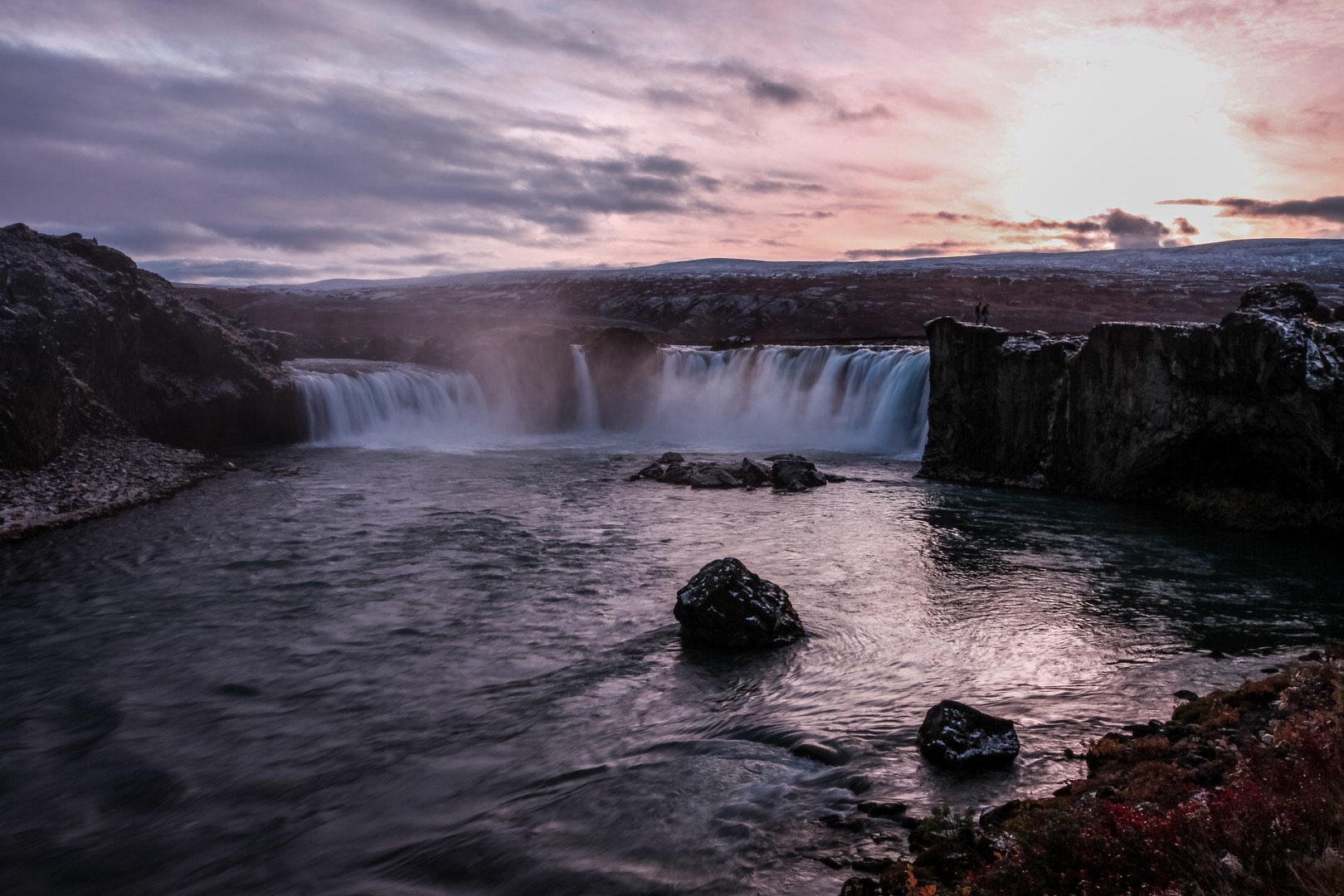You are here
Goðafoss is a 12-meter (39-foot) high waterfall in the northeastern region of Iceland that is over 30 m (98 ft) wide and has an important association with the country’s conversion to Christianity. Large rocky promontories divide its horseshoe shape into several sections as the water continues to carve out a canyon of hardened lava. The falls is only about 45 kilometers (27 miles) from Húsavík, 50 kilometers (31 miles) from Akureyri, and it is easily accessible along Route N1, the “Ring Road.” There is a small parking area and toilets right next to the falls with walking paths on both sides of the river for you to explore. On the east bank there is an observation platform with paths to the river base. There are limited safety implements on the western bank, so watch your step and don’t get too close to the edge.
This is often considered one of the most beautiful waterfalls in the country. In fact its nickname is "Beauty," versus Dettifoss, the "Beast," its neighbor to the east. If the sun is out, you are likely to catch double rainbows bridging the rushing water. The water’s source lies in Vatnajökull, Iceland’s largest glacier, and flows down the Skjálfandafljót, one of Iceland’s longest rivers. It flows through the Bárðardalur, the surrounding valley, and eventually empties into Skjálfandi, the bay to the north. On its way, the water cuts through a massive lava field called Suðurárhraun, or Frambruni, exposing the underlying layers of ash and rock which are over 7,000 years old. The canyon below the falls is about 100 meters (328 feet) wide and 3 kilometers (1.9 miles) long and reveals many layers of volcanic rock, a testament to the country’s eruptive history. Flood levels of over 6,780 cubic meters per second (24,000 cubic feet per second) have been recorded here and can fill up the gorge to a point that nearly covers the falls; this would be almost five times the average summer volume of the river!
Geitafoss, Goðafoss´ little sister, is the smaller downstream waterfall. It is easily seen from the road bridge crossing the Skjálfandafljót, but it is often overlooked due to the location of the parking area. It drops approximately 6 meters (20 feet) into a narrow chute adjacent to a partially formed natural arch in the adjoining cliff wall. There is a footbridge downstream of Geitafoss, and you can walk across the eastern side which offers the best opportunity to view both waterfalls.
In the year 1000, there were growing disputes between Christians and those who worshipped the old Nordic gods. When the representatives at Alþingi could not come to a resolution on which religion to accept for all of Iceland, Þorgeir Þorkelsson, chieftain of the Ljósavatn district and Lawspeaker, was entrusted with the momentous task of making a decision. The story, preserved in Ari Þorgilsson's Íslendingabók, "Íslendingabók," claims that Þorgeir, a heathen worshipper at the time, crawled into his tent, buried himself beneath a stack of hides and emerged three days later saying that Icelanders should adopt the Christian faith. There was no dispute from the other members. Modern myth says that upon his return to Ljósavatn, he threw his statues of Norse gods into the waterfall in a symbolic act of the conversion. Goðafoss is Icelandic for “waterfall of the Gods,” and thus derives its name from this event. A window in Akureyrarkirkja, the Cathedral of Akureyri, illustrates this story; however, the written book does not mention Þorgeir throwing his idols into Goðafoss. In the year 2000, a church, Þorgeirskirkja, was built by the nearby Lake Ljósavatn commemorating the 1000th year anniversary of Christianity in the country. This church is open to visitors during the summer.
Fosshóll is a small guesthouse and restaurant with views to the falls and free WiFi for customers. It is open from May 15 to September 15, and operates the small campsite nearby. Next door, there is a service center with a store and gas station.
During World War II, the MS Goðafoss, named after this waterfall, was an Icelandic ship used to transport both freight and passengers. Unfortunately, it was sunk by a German U-Boat, which resulted in a great loss of life.
Goðafoss is one of several impressive waterfalls on the Skjálfandafljót including Ingvararfoss, Hrafnabjargafoss, Barnafoss and the famous Aldeyjarfoss with its amphitheater of basalt columns. The Sprengisandur Route begins here at Goðafoss and is an unpaved interior route to the highlands that follows the Skjálfandafljót. It turns into F26, a road that requires an appropriate four-wheel-drive vehicle, before it reaches Aldeyjarfoss.
Logistics + Planning
Current Weather: Powered by Dark Sky






























Comments
Sign In and share them.